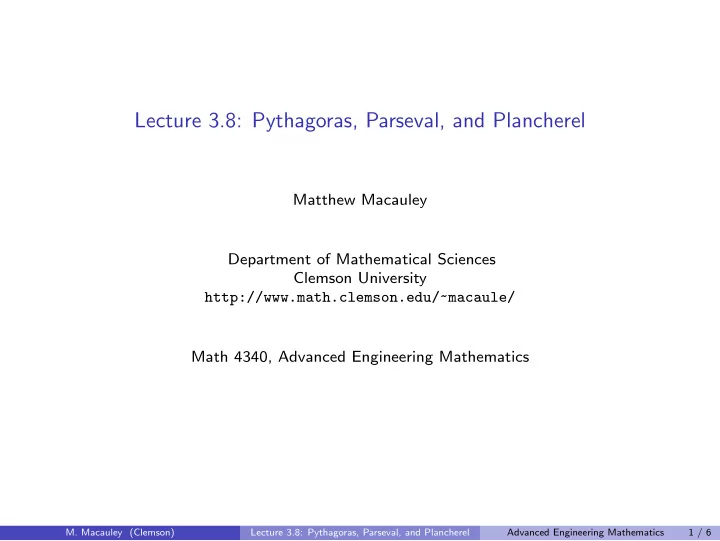

Lecture 3.8: Pythagoras, Parseval, and Plancherel Matthew Macauley Department of Mathematical Sciences Clemson University http://www.math.clemson.edu/~macaule/ Math 4340, Advanced Engineering Mathematics M. Macauley (Clemson) Lecture 3.8: Pythagoras, Parseval, and Plancherel Advanced Engineering Mathematics 1 / 6
Our journey from R n to Fourier transforms In the beginning of this class, we started with standard Euclidean space, R n . The dot product gave us a notion of geometry: lengths, angles, and projections. Our favorite orthonormal basis was { e 1 , . . . , e n } . Moving on to the space Per 2 L ( C ) of piecewise 2 L -periodic functions, we defined an inner product, which gave us a notion of geometry: norms, angles, and projections. Our favorite � � e i π nx / L | n ∈ Z orthonormal basis was . � Let L 2 ( R ) be the set of square-integrable functions, i.e., || f || 2 := R | f | 2 dx < ∞ . The Fourier transform of f ∈ L 2 ( R ) can be thought of as a “continuous” version of a Fourier series. Definition We defined the Fourier transform of f ∈ L 2 ( R ) and its inverse transform as � ∞ � ∞ f ( x ) = 1 � f ( x ) e − i ω x dx , � f ( x ) e i ω x d ω. f ( ω ) := and 2 π −∞ −∞ Think of ω as angular frequency. Another definition of the Fourier transform was in terms of oscillatory frequency, ξ = ω/ (2 π ): � ∞ � ∞ � f ( x ) e − 2 π i ξ x dx , � f ( x ) e 2 π i ξ x d ξ f ( ξ ) := and f ( x ) = −∞ −∞ M. Macauley (Clemson) Lecture 3.8: Pythagoras, Parseval, and Plancherel Advanced Engineering Mathematics 2 / 6
Generalizations of a celebrated theorem of the ancient Greeks Pythagorean theorem for vectors in R n Given a vector v = c 1 e 1 + · · · + c n e n , n � || v || 2 = � v , v � = c 2 i . i =1 Parseval’s identity for Fourier series in Per 2 L ( C ) � ∞ c n e i π nx / L , Given a Fourier series f ( x ) = n = −∞ � L � ∞ || f || 2 = � f , f � = 1 | f ( x ) | 2 dx = c 2 n . 2 L − L n = −∞ Plancherel’s theorem for Fourier transforms in L 2 ( R ) If f is square-integrable, then � ∞ � ∞ � �� � �� � 2 = � � �� f , � | � f ( ξ ) | 2 d ξ = | f ( x ) | 2 dx = � f , f � = || f || 2 . f f � = −∞ −∞ M. Macauley (Clemson) Lecture 3.8: Pythagoras, Parseval, and Plancherel Advanced Engineering Mathematics 3 / 6
Parseval’s identity for Fourier transforms Plancherel’s theorem says that the Fourier transform is an isometry. It follows from a more general result. Parseval’s identity for Fourier transforms �� � If f , g ∈ L 2 ( R ), then � f , g � = f , � . g Proof M. Macauley (Clemson) Lecture 3.8: Pythagoras, Parseval, and Plancherel Advanced Engineering Mathematics 4 / 6
Introduction Parseval’s identity for real Fourier series � ∞ If f ( x ) = a 0 a n cos n π x + b n sin n π x 2 + L , then L n =1 � L � � � 2 dx = 1 ∞ || f || 2 = � f , f � := 1 2 a 2 a 2 n + b 2 f ( x ) 0 + n . L − L n =1 M. Macauley (Clemson) Lecture 3.8: Pythagoras, Parseval, and Plancherel Advanced Engineering Mathematics 5 / 6
An application of Parseval’s identity Sum of inverse squares � ∞ n 2 = 1 + 1 1 4 + 1 9 + 1 16 + 1 Compute the infinite series 25 + · · · . n =1 M. Macauley (Clemson) Lecture 3.8: Pythagoras, Parseval, and Plancherel Advanced Engineering Mathematics 6 / 6
Recommend
More recommend